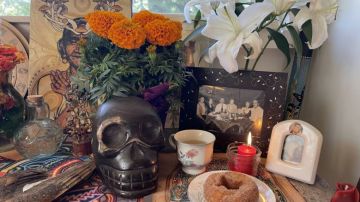How to Build an Ancestral Altar for El Día de Los Muertos
Erika Buenaflor is a modern-day curandera who utilizes her vast experience in curanderismo, and knowledge of ancient Mesoamerican shamanism to reveal how this sacred wisdom can help people heal holistically

Photo courtesy of Erika Buenaflor
Erika Buenaflor is a modern-day curandera who utilizes her vast experience in curanderismo, and knowledge of ancient Mesoamerican shamanism to reveal how this sacred wisdom can help people heal holistically. She’s published several books on curanderismo and is the founder of Realize Your Bliss.
If you are interested in strengthening your connection to your ancestors and would like to honor them, then consider creating an ancestral altar this coming el Día de Los Muertos, October 31st to November 2nd. This beautiful celebration integrates Spanish holy days and Mesoamerican customs that venerate our ancestors, strengthen their soul energies and connection with us, and enables them to intervene on our behalf. Along with dancing, elaborate attire, feasts and many other kinds of veneration rites, it is customary to create an ancestral altar or place additional special items on an existing ancestral altar, during these holy days.
So where should this ancestral altar be located at and what items need to be on it, so we may strengthen our connection and honor our ancestors? Read on to learn more about how to get started.
wp_*posts
Location of Your Altar
As I discuss in my upcoming book, Veneration Rites of Curanderismo: Invoking the Sacred Energy of Our Ancestors, in deciding where you should place your altar, consider its purpose, your connection with your ancestor, and whether it will be a temporary or permanent altar. While I may typically recommend to create a permanent altar in a peaceful space at home, el Día de Los Muertos altars can include more public displays of affection, adoration, and veneration. The first time I celebrated el Día de Los Muertos, I created a large multilayered altar for my father adorned with his favorite foods, drinks, hundreds of marigolds, pictures of him, calaveras in my front yard.
This public display was a reclamation of my culture and creation of a safe space to finally ask about my father who had been assassinated when I was very young. Although ancestral altars on these holiday days can be a public spectacle of adoration, they are always intimate and personal, so yes, we should always stop and tune into its purpose and our connection(s) with the ancestor(s) we are honoring, before deciding its location. Perhaps if this ancestral connection is still somewhat fresh, you may want to create it in a more private place in your house that you have a strong connection to, like your bedroom or den. You may also want to place it in a common area of the house, a place you and possibly your family may frequent. Either way, before deciding, close your eyes, take some slow inhales and exhales, ask your ancestor(s) where they would like to have their altar at and see what feels good for you.

If this going to be a more permanent altar, then please consider that the altar will be a resting space for your ancestors, so tune into what this looks and feels like, then decide. If it’s going to be an outdoor altar, consider smudging the location with an herbal smudge bundle or offering copal (placing copal on a charcoal tablet and on a brazier) around the space, recognizing it as a sacred space for your altar, before creating it. If it’s going to be indoors, clean and cleanse your living space.
wp_*posts
What to Place on the Ancestral Altar
You want to link your ancestor(s) to your altar, and essentially this can be any sacred item that helps you feel connected to them, such as their picture, items they loved and if possible belonged to them, tools of their favorite hobby or trade, a clay or sugar skull calavera with their name on top or one of their personal trademarks—hoop earrings, hat, curly hair, mole and other cultural items that embody their essence in some way.
Consider also placing items that provide them comfort in the afterlife, strengthen their soul energies, and further facilitate their presence. Ancient Mesoamerican peoples believed that aromas, especially pleasant aromas were something our ancestors consumed and made offerings of beautiful fragrant aromas on their ancestral altars. This tradition lives on and is highly recommended. Your ancestors’ favorite aromatic food and drinks welcomes their presence.

If you are unsure of what their favorite fragrant food or beverages were, humbly offer the ones you love. It’s likely they will love them too. The pungent smell of cempasúchil were also believed to be able to pierce into the non-ordinary realms, where the ancestors resided, and therefore were and are still placed on our ancestral altars. Flowers, in general, however were highly revered for their medicinal and spiritual properties— they were believed to connect us to a paradisal floral realm, so offering many kinds of flowers was and is still common. If you have a permanent altar, like me, consider splurging on additional fragrant flowers, foods, beverages, and incense or resin.
There are also sacred items that are still understood to act as portals that help facilitate the presence and veneration of our ancestors on these holy days. Some of the most common items, include water, mirrors, and fire. We can use all three but at least one of them is common. I personally use all three, and again only one of them is part of our traditions. Before placing the water on the altar, I like to say a prayer of gratitude to my ancestors over the water. The mirror can be a traditional glass mirror or one made of turquoise, pyrite, or obsidian. Before placing it on the altar, cleanse it with a soft cloth, and Florida water, rose water, or rubbing alcohol. A nice touch is to also place a marigold or two next to the mirror. As for a fire, a lit charcoal tablet or candle can act as a portal for our ancestors. The use of candles, especially fragrant or seven-day candles are still the most common.If this is going to be a temporary ancestral altar, please consider leaving a picture or two of the ancestor(s) you honored in your living room, or another room or space you frequently visit. This way your ancestor(s) can stay connected to you throughout the year and feel welcomed in your living space.
Keep in mind that while there are traditional ways to build an altar, this is also personal ritual that you can make your own to honor your loved ones in a way that feels right for you. That is the beauty of this ritual – it’s as much for us as it is for our ancestors.

















